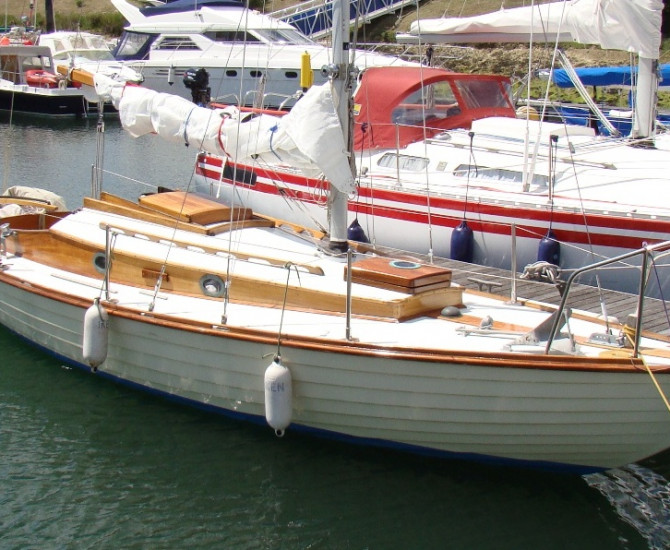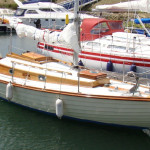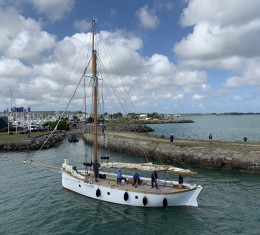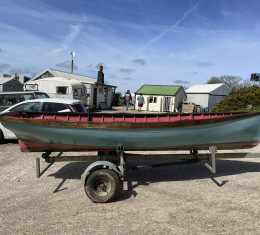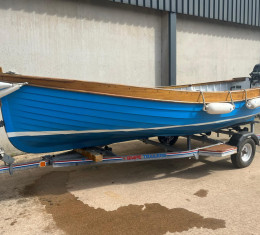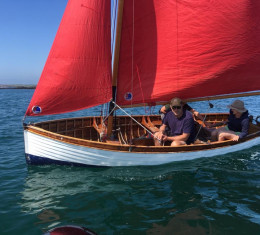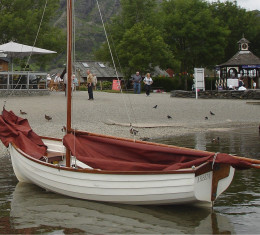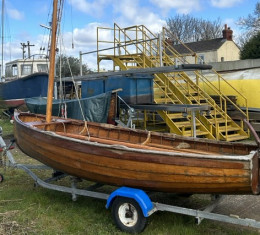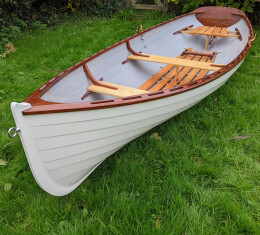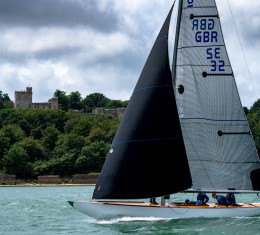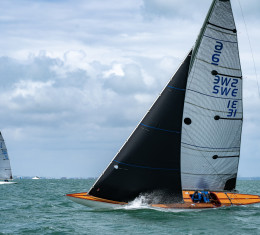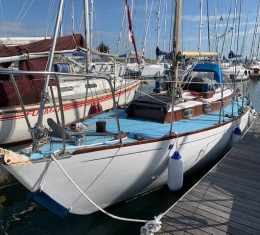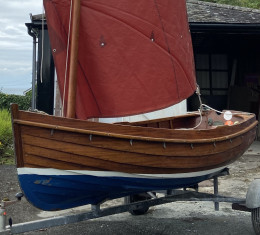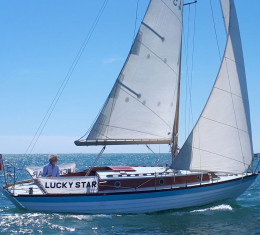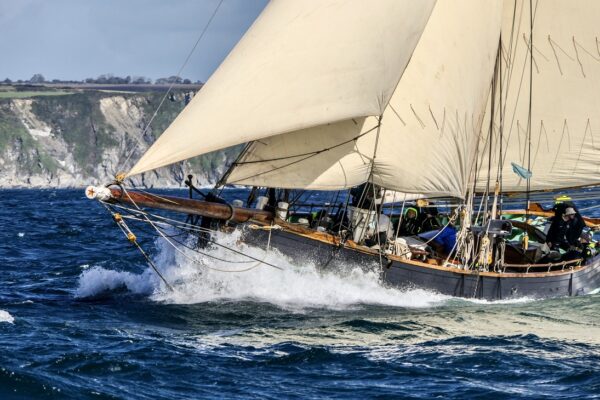Sailing yachts
Full specification
Wooden ships comments on this Cyril White Folkboat
A particularly special example of this famous class, one of the superb Folkboats built by Cyril White of Brightlingsea, 1964.
The Folkboat began in 1942 when the Scandinavian Racing Union wanted a stock design which could be produced economically in order to get more people out on the water and participating in sailing. A committee of respected designers could not agree on a design so the Union engaged Swedish Tord Sunden to amalgamate the best of all the designs put forward and the Folkboat, The People’s Boat, was born.
The result has been more successful than any of that first committee could ever have envisaged and the Folkboat is probably the single most successful design ever built with more than 4000 currently known to be in existence.
The first boat was built in Goteborg, Sweden in 1946. Tor Sunden modified the design for carvel plank construction in 1966 and in 1968 the first grp Folkboat was produced.
The racing people often say that the wooden boats are faster than the grp boats.
The original design known as the Nordic Folkboat was of clinker planking construction with a small coach-roof as far forward as the mast
and sitting head-room only in the cabin. The cock-pit was a generous size allowing 4 people to sail. The concept was kept very simple from the beginning with no engine, no heads and a simple fractional bermudian sloop rig.
A very active class association keeps a strict eye on the specifications which have changed little since the early days. As the popularity of the class spread beyond the Baltic various national associations grew up and with the introduction of carvel planked boats in 1966 variations of the coach-roof design were produced to give more space in the cabin. Folkboats were then built in many countries including UK. Poland, Hungary and East Germany had a large production which were usually cheaper than UK and Scandinavian boats.
The original Nordic Folkboat remains the classic even though limited in comforts. The English Folkboat adopted a larger coach-roof often stepped up into a dog-house to give more volume and standing head-room in part of the cabin while the Eastern European Folkboats went further with rather large coach-roofs which many nowadays think are a step too far from the original concept.
Cyril White very cleverly used the original clinker planked Nordic Folkboat hull but added his own coach-roof which is just a size bigger than the tiny Nordic design and running forward of the mast and tapering down in width and height. He kept the low profile in the coamings which is so important when respecting the original design but gained a little more head-room by building a marked camber into the roof. His cock-pit is bigger than the English Folkboat and the cabin is kept open plan, uncluttered by excessive joinery.
The result is probably the best of all Folkboats ever built.
Construction.
Clinker planked larch fastened with copper nails and roves to steam bent oak timbers on an oak back-bone. Garboards and hood ends all fastened with bronze screws.
Substantial grown oak floors maintain the strength of the back-bone.
Long external 1.16tons (1050kg) iron ballast keel
Iron keel bolts.
Deck
The deck is laid in marine ply, sheathed with grp and painted with off-white deck paint. Almost invisible fine grit “patches” render the deck non-slip.
Laminated oak deck beams, mahogany carlins with a pair of heavy section hanging knees either side of the mast.
Varnished mahogany king plank with varnished sapele toe rail and running strake.
This deck is particularly attractive in it’s simplicity, uncluttered, with good width side decks allowing safe passage.
On the fore deck, an oak sampson post followed by the inner fore-stay attachment fitting and further back a bronze mush-room vent. The chain spurling pipe is off-set to stbd. Substantial stemhead fitting with single centre-line chain roller.
Stainless steel pulpit, 4 stanchion post set on teak pads with single guard wire.
Pair of teak bar/chromed bronze mooring cleats on the aft deck.
Long and short head-sail tracks on each side deck.
Coach-roof.
Varnished mahogany coamings with 2 fixed oval lights in bronze bezels each side.
Quadrant at mai deck level and half-round quadrant at upper level.
Coach-roof deck in grp sheathed marine ply.
Varnished sapele hatch on the forward end.
Sliding hatch cabin entrance with wash-boards.
Varnished mahogany grab rails each side.
Cock-pit.
The coach-roof coamings continue aft to form the cock-pit coamings sweeping gracefully down to aft.
Varnished mahogany bridge deck across the entrance hatch with a varnished mahogany seat locker each side. Mahogany helmsman’s seat across the after end under the tiller.
The seat lockers do not run back into the after corners of the cock-pit so that with the helmsman’s seat removed there is plenty of space for the helmsman to move to either side when heeled. The side of the hull above the sole is battened to take the helmsman’s foot.
Loose fitted scrubbed iroko sole boards allow water to drain straight down into the bilge and not weigh down the stern in the event of a serious wave coming over.
A vertical oak post in the middle of the cock-pit takes the main sheet block.
Morse engine controls on the stbd seat/locker.
Varnished oak tiller to transom-hung rudder.
Rig
Usual fractional sloop Folkboat rig on a Sailspar silver anodised aluminium mast with integral luff groove stepped through the coach-roof onto the keel.
Single spreaders with jumper struts above.
2002 stainless steel rigging. Single lowers from the spreaders set well aft, cap shrouds to the jumper struts, diamonds above to support the head of the mast. Single fore stay to the fore deck fitting set well aft of the stemhead.
Split standing back-stay to the quarter with tackle tensioner.
Norseman terminals and stainless steel rigging screws to internal stainless steel chain plates.
Varnished spruce square section boom with sail outhaul.
Harken main sheet blocks with jammer on the lower block.
Tackle kicker.
Winches.
Pair of chromed Lewmar 6 single speed top action sheet winches mounted on stainless steel brackets on the cock-pit coamings.
Tails to cleats on the inside of the coaming.
Pair of Lewmar 6 single speed top action halyard winches mounted on the mast.
Spinnaker pole loop on the fore face of the mast.
Sails
Mainsail 183sq’ loose-footed slab reef by Parker and Kay 2001 in very good condition.
Genoa 75sq’ by Parker and Kay, 2001 in very good condition.
No 1 genoa, ex Dragon race sail.
Spinnaker
Storm jib – unused.
Spinnaker pole.
Running rigging in Spectra and polyester braid, new 2002.
Covers
Mainsail and boom cover
Over boom cock-pit cover.
Over boom fore deck, coach-roof, cock-pit and transom cover, new 2011
Full length winter cover with a 3-section frame support.
Engine
1985 Yanmar 1GM10 single cylinder naturally aspirated salt water cooled 4-stroke diesel engine, flexibly mounted on a fabricated mild steel frame bolted t the two aftermost oak transverse floors.
Single lever controls to conventional centre-line shaft drive with 3-blade bronze rpop.
Fuel
Stainless steel fuel tank in the bilge aft of the mast.
Electrics.
12v 85amp/hr marine battery secured in the bilge just aft of the mast, charged by 35amp belt driven alternator on the engine.
6-fuse switch panel to the various lights.
240v mains shore power socket through approved 2012 RCCB trip isolator.
Accommodation. 2 berths
Access to the internal surfaces of the hull, deck-head and coach-roof is unrestricted by fixed linings, panels and the limited furniture.
Varnished mahogany bunk boards and slatted pine bunk surfaces.
New mattresses in 2011 in dark blue vinyl piped in Swedish yellow.
Galley work surface, chart desk, cave lockers and shelves in mostly varnished, some painted mahogany ply with solid mahogany trim
Hanging locker to stbd.
Thetford chemical WC fitted forward of the mast – unused.
Taylor 028 gimballed 2-burner paraffin cooker. (not currently installed but gimbals in position)
Scrubbed iroko sole boards.
Equipment.
Plastimo compass mounted on the port side bulkhead or at the chart desk
Raymarine ST40 Bidata giving speed, log, trip water temp, and depth with hi and lo depth alarms. Single cock-pit dial.
Garmin GPS72 12 channel hand held GPS with WAAS, water-proof and floating.
Swiftech 25/1 VHF/FM radio. Masthead arial
ICOM IC-M33 portable and water-proof VHF (call sign 2ERB7 registered to present owner)
Masthead Windex
Barometer
Masthead tri-colour nav light.
4 named fenders
Mooring warps
Boom crutch
2 x boathooks
Beaching legs
Manual bilge pump
12v 800gph Rule bilge pump with auto-float switch.
2007 Wetline 260 ECO inflatable dinghy with pump and oars.
Pair of long fend-off pole with soft ends – for fending off when berthing in tight marina berths – every single-hander should have them.
We consider the Cyril White Folkboats to be amongst the best ever built both in build quality and design and this is probably the best of all his boats.
Over the past few years she has had 3 knowledgeable and dedicated owners.
Reputedly sailed round UK by her 1987 owner Dr Paul Morris.
Sold by him in 1993 to Donald Warren from Suffolk then to a Roger Watkins
Will Taylor-Jones of Suffolk bought her in 2000. Will was then the quality control manager at Oyster Yachts and carried out a 2-stage refit subsequently racing her with some success. Her rig dates from Will’s ownership.
Sold by Wooden Ships to Derek Bullman, a meticulous owner who spent a lot of money perfecting the yacht with new fore hatch, rubbing strakes, toe rails, quadrants, re-sheathing the deck in epoxy/glass and more to bring her up to her current near-perfect condition.
Sold again by Wooden Ships to the present owner, a retired director of Brookes and Gatehouse who long yearned to own just such a boat and finally achieved his ambition by buying the very best Folkboat available in 2010. He has taken great pride and satisfaction in caring for her and ensuring her continued perfection.
Disclaimer:
These particulars have been prepared in good faith from information provided by the Vendors and are intended as a guide, Wooden Ships cannot guarantee or warrant the accuracy of this information nor warrant the condition of the vessel. The Purchaser should instruct his agent or surveyor to validate all details as necessary and satisfy himself with the condition of the vessel and its equipment.
Wooden Ships classic yachts brokers have an extensive database of boats for sale. With a wide range of sailboats, classic yachts, motor yachts and small classic boats, Wooden Ships has one of the largest selections of traditional wooden boats and yachts for sale in the UK.
Disclaimer:
These particulars have been prepared in good faith from information provided by the Vendors and are intended as a guide, Wooden Ships cannot guarantee or warrant the accuracy of this information nor warrant the condition of the vessel. The Purchaser should instruct his agent or surveyor to validate all details as necessary and satisfy himself with the condition of the vessel and its equipment.

